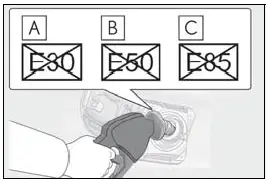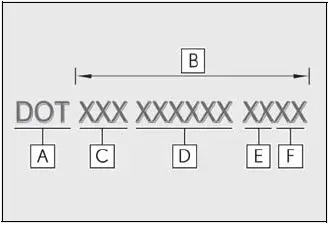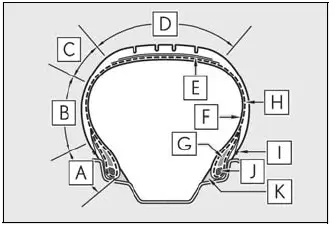Lexus ES250 2023 Fuel Information User Manual
Introduction
The premium automobile division of the Japanese automaker Toyota, Lexus, produces the Lexus ES250, a sedan. I don’t have the specifics for the 2023 model, but I can give you some general knowledge about how fuel considerations apply to automobiles.
Fuel Type: Petrol is the preferred fuel type for the Lexus ES250. For optimum performance, it’s crucial to utilize the fuel type that the manufacturer has recommended. For further information on the precise fuel needs of the 2023 model, consult the user guide or get in touch with Lexus customer service. Petrol is available in a variety of octane ratings, often 87, 89, or 91. The suggested octane rating for the Lexus ES250 can be found in the owner’s manual or on the gasoline filler door.
Fuel Economy: Details on fuel efficiency, including projected miles per gallon (MPG) or litres per 100 kilometres (L/100km) for both city and highway driving, are included in the Lexus ES250 2023 user handbook. Depending on the road, the gasoline, and the individual driver, this can change.
Fuel Tank Capacity
The vehicle’s fuel tank capacity, or how much fuel it can contain, should be mentioned in the user handbook. Planning refuelling stops for lengthy journeys might be aided by the information provided.
Fuel Information
You must only use unleaded gasoline.
Select octane rating 87 (Research Octane Number 91) or higher. Use of unleaded gasoline with an octane rating lower than 87 may result in engine knocking. Persistent knocking can lead to engine damage.
At minimum, the gasoline you use should meet the specifications of ASTM D4814 in the U.S.A.
Gasoline quality
In very few cases, drivability problems may be caused by the brand of gasoline you are using. If drivability problems persist, try changing the brand of gasoline. If this does not correct the problem, consult your Lexus dealer.
Recommendation of the use of gasoline containing detergent additives
- Lexus recommends the use of gasoline that contains detergent additives to avoid the build-up of engine deposits.
- All gasoline sold in the U.S.A. contains minimum detergent additives to clean and/or keep clean intake systems, per EPA’s lowest additives concentration program.
- Lexus strongly recommends the use of Top Tier Detergent Gasoline. For more information on Top Tier Detergent Gasoline and a list of marketers, please go to the official website www.toptiergas.com.
Recommendation of the use of low emissions gasoline
Gasolines containing oxygenates such as ethers and ethanol, as well as reformulated gasolines, are available in some cities. These fuels are typically acceptable for use, providing they meet other fuel requirements. Gasolines containing oxygenates such as ethers and ethanol, as well as reformulated gasolines, are available in some cities. These fuels are typically acceptable for use, providing they meet other fuel requirements.
Non-recommendation of the use of blended gasoline
Use only gasoline containing up to 15% ethanol. DO NOT use any flex-fuel or gasoline that could contain more than 15% ethanol, including from any pump labeled E30 (30% ethanol [ A ]), E50 (50% ethanol [ B ]), E85 (85% ethanol [ C ])(which are only some examples of fuel containing more than 15% ethanol).

- If you use gasohol in your vehicle, be sure that it has an octane rating no lower than 87.
- Lexus does not recommend the use of gasoline containing methanol.
Non-recommendation of the use of gasoline containing MMT
Some gasoline contains an octane enhancing additive called MMT (Methylcyclopentadienyl Manganese Tricarbonyl). Lexus does not recommend the use of gasoline that contains MMT. If fuel containing MMT is used, your emission control system may be adversely affected. The malfunction indicator lamp on the instrument cluster may come on. If this hap-pens, contact your Lexus dealer for service.
If your engine knocks
- Consult your Lexus dealer.
- You may occasionally notice light knocking for a short time while accelerating or driving uphill. This is normal and there is no need for concern.
NOTICE
Notice on fuel quality
- Do not use improper fuels. If improper fuels are used, the engine will be dam-aged.
- Do not use leaded gasoline.
Leaded gasoline can cause damage to your vehicle’s three-way catalytic converters causing the emission control system to malfunction. - Do not use gasohol other than the type previously stated.
Other gasohol may cause fuel system damage or vehicle performance problems. - Using unleaded gasoline with an octane number or rating lower than the level previously stated may cause persistent heavy knocking.
At worst, this may lead to engine dam-age and will void the vehicle warranty.
Fuel-related poor drivability
If poor drivability (poor hot starting, vaporization, engine knocking, etc.) is encountered after using a different type of fuel, discontinue the use of that type of fuel.
When refueling with gasohol
Take care not to spill gasohol. It can damage your vehicle’s paint.
Tire information
Typical tire symbols
Full-size tire

- A :Tire size
B: DOT and Tire Identification Number (TIN)
C: Location of treadwear indicators
D : Tire ply composition and materials
Plies are layers of rubber-coated parallel cords. Cords are the strands which form the plies in a tire.
E : Radial tires or bias-ply tires
A radial tire has “RADIAL” on the sidewall. A tire not marked “RADIAL” is a biasply tire.
F: TUBELESS or TUBE TYPE
A tubeless tire does not have a tube and air is directly put into the tire. A tube type tire has a
tube inside the tire and the tube maintains the air pressure.
G : Load limit at maximum cold tire inflation pressure
H: Maximum cold tire inflation pressure
This means the pressure to which a tire may be inflated.
I : Uniform tire quality grading
For details, see “Uniform Tire Quality Grading” that follows.
J : Summer tires or all season tires
An all season tire has “M+S” on the sidewall. A tire not marked “M+S” is a summer tire. - Compact spare tire

A: Tire size
B :DOT and Tire Identification Number (TIN) Location of treadwear indicators
C : Tire ply composition and materials
Plies are layers of rubber-coated parallel cords. Cords are the strands which form the plies in a tire.
E Radial tires or bias-ply tires
A radial tire has “RADIAL” on the sidewall. A tire not marked “RADIAL” is a bias-ply tire.
F :TUBELESS or TUBE TYPE
G :A tubeless tire does not have a tube and air is directly put into the tire. A tube type tire has a tube inside the tire and the tube maintains the air pressure.
H: Load limit at maximum cold tire inflation pressure
I:Load limit at maximum cold tire inflation pressure
A compact spare tire is identified by the phrase “TEMPORARY USE ONLY” molded on its sidewall. This tire is designed for temporary emergency use only.
Typical DOT and Tire Identification Number (TIN)
Type A
- DOT symbol*
- Tire Identification Number (TIN)
- Tire manufacturer’s identification mark
- Tire size code
- Manufacturer’s optional tire type code (3 or 4 letters)
- Manufacturing week
- Manufacturing year
The DOT symbol certifies that the tire conforms to applicable Federal Motor Vehicle Safety Standards.
Type B
- Tire use (P = Passenger car, T = Temporary use)
- Section width (millimeters)
Aspect ratio (tire height to section width)
Tire construction code (R = Radial, D = Diagonal) - Wheel diameter (inches)
- Load index (2 digits or 3 digits)
- Speed symbol (alphabet with one letter)
Tire dimensions Tire section names
Tire section names

- Bead
- Sidewall
- Shoulder
- Tread
- Belt
- Inner liner
- Reinforcing
- rubber
- Carcass
- Rim lines
- Bead wires
- Chafer
Uniform Tire Quality Grading
This information has been prepared in accordance with regulations issued by the National Highway Traffic Safety Administration of the U.S. Department of Transportation. It provides the purchasers and/or prospective purchasers of Lexus vehicles with information on uniform tire quality grading. Your Lexus dealer will help answer any questions you may have as you read this information.
DOT quality grades
All passenger vehicle tires must con-form to Federal Safety Requirements in addition to these grades. Quality grades can be found where applicable on the tire sidewall between tread shoulder and maximum section width. For example: Treadwear 200 Traction AA Temperature A
Treadwear
The treadwear grade is a comparative rating based on the wear rate of the tire when tested under controlled conditions on a specified government test course. For example, a tire graded 150 would wear one and a half (1 – 1/2) times as well on the government course as a tire graded 100. The relative performance of tires depends upon the actual conditions of their use. Performance may differ significantly from the norm due to variations in driving habits, service practices and differences in road characteristics and climate.
Traction AA, A, B, C
The traction grades, from highest to lowest, are AA, A, B and C, and they represent the tire’s ability to stop on wet pavement as measured under con-trolled conditions on specified government test surfaces of asphalt and concrete. A tire marked C may have poor traction performance.
Warning: The traction grade assigned to this tire is based on braking (straight ahead) traction tests and does not include cornering (turning) traction.
Temperature A, B, C
The temperature grades are A (the highest), B, and C, representing the tire’s resistance to the generation of heat and its ability to dissipate heat when tested under controlled conditions on a specified indoor laboratory test wheel. Sustained high temperature can cause the material of the tire to degenerate and reduce tire life, and excessive temperature can lead to sudden tire failure. Grade C corresponds to a level of performance which all passenger car tires must meet under the Federal Motor Vehicle Safety Standard No. 109.
Grades B and A represent higher levels of performance on the laboratory test wheel than the minimum required by law.
Warning: The temperature grades of a tire assume that it is properly inflated and not overloaded. Excessive speed, underinflation, or excessive loading, either separately or in combi-nation, can cause heat buildup and possible tire failure.
Glossary of tire terminology
| Tire related term | Meaning |
| Cold tire inflation pressure | Tire pressure when the vehicle has been parked for three hours or more, or has not been driven more than 1 mile or 1.5 km under that condition |
| Maximum inflation pressure | The maximum cold inflated pressure to which a tire may be inflated, shown on the sidewall of the tire |
| Recommended inflation pressure | Cold tire inflation pressure recommended by a manufacturer |
| Accessory weight | The combined weight (in excess of those standard items which may be replaced) of automatic transmission, power steering, power brakes, power windows, power seats, radio and heater, to the extent that these items are available as factory-installed equipment (whether installed or not) |
| Curb weight | The weight of a motor vehicle with standard equipment, including the maximum capacity of fuel, oil and coolant, and if so equipped, air conditioning and additional weight optional engine |
| Maximum loaded vehicle weight | The sum of:
|
| Normal occupant weight | 150 lb. (68 kg) times the number of occupants specified in the sec- ond column of Table 1* that follows |
| Occupant distribution | Distribution of occupants in a vehicle as specified in the third column of Table 1* below |
| Production options weight | The combined weight of installed regular production options weigh- ing over 5 lb. (2.3 kg) in excess of the standard items which they replace, not previously considered in curb weight or accessory weight, including heavy duty brakes, ride levelers, roof rack, heavy duty battery, and special trim |
| Rim | A metal support for a tire or a tire and tube assembly upon which the tire beads are seated |
| Rim diameter (Wheel diameter) | Nominal diameter of the bead seat |
| Rim size designation | Rim diameter and width |
| Rim type designation | The industry manufacturer’s designation for a rim by style or code |
| Rim width | Nominal distance between rim flanges |
| Vehicle capacity weight (Total load capacity) | The rated cargo and luggage load plus 150 lb. (68 kg) times the vehicle’s designated seating capacity |
| Vehicle maximum load on the tire | The load on an individual tire that is determined by distributing to each axle its share of the maximum loaded vehicle weight, and divid- ing by two |
|
Vehicle normal load on the tire |
The load on an individual tire that is determined by distributing to each axle its share of curb weight, accessory weight, and normal occupant weight (distributed in accordance with Table 1* below), and dividing by two |
| Weather side | The surface area of the rim not covered by the inflated tire |
| Bead | The part of the tire that is made of steel wires, wrapped or reinforced by ply cords and that is shaped to fit the rim |
| Bead separation | A breakdown of the bond between components in the bead |
|
Bias ply tire |
A pneumatic tire in which the ply cords that extend to the beads are laid at alternate angles substantially less than 90 degrees to the centerline of the tread |
| Carcass | The tire structure, except tread and sidewall rubber which, when inflated, bears the load |
| Chunking | The breaking away of pieces of the tread or sidewall |
| Cord | The strands forming the plies in the tire |
| Cord separation | The parting of cords from adjacent rubber compounds |
| Cracking | Any parting within the tread, sidewall, or inner liner of the tire extending to cord material |
| CT | A pneumatic tire with an inverted flange tire and rim system in which the rim is designed with rim flanges pointed radially inward and the tire is designed to fit on the underside of the rim in a manner that encloses the rim flanges inside the air cavity of the tire |
| Extra load tire | A tire designed to operate at higher loads and at higher inflation pressures than the corresponding standard tire |
| Groove | The space between two adjacent tread ribs |
| Innerliner | The layer(s) forming the inside surface of a tubeless tire that contains the inflating medium within the tire |
| Innerliner separation | The parting of the inner liner from cord material in the carcass |
| Intended outboard sidewall |
|
| Light truck (LT) tire | A tire designated by its manufacturer as primarily intended for use on lightweight trucks or multipurpose passenger vehicles |
| Load rating | The maximum load that a tire is rated to carry for a given inflation pressure |
| Maximum load rating | The load rating for a tire at the maximum permissible inflation pressure for that tire |
| Maximum permissible inflation pressure | The maximum cold inflation pressure to which a tire may be inflated |
| Measuring rim | The rim on which a tire is fitted for physical dimension requirements |
| Open splice | Any parting at any junction of tread, sidewall, or inner liner that extends to cord material |
| Outer diameter | The overall diameter of an inflated new tire |
| Overall width | The linear distance between the exteriors of the sidewalls of an inflated tire, including elevations due to labeling, decorations, or protective bands or ribs |
| Passenger car tire | A tire intended for use on passenger cars, multipurpose passenger vehicles, and trucks, that have a gross vehicle weight rating (GVWR) of 10,000 lb. or less. |
| Ply | A layer of rubber-coated parallel cords |
| Ply separation | A parting of rubber compound between adjacent plies |
| Pneumatic tire | A mechanical device made of rubber, chemicals, fabric and steel or other materials, that, when mounted on an automotive wheel, pro- vides the traction and contains the gas or fluid that sustains the load |
| Radial ply tire | A pneumatic tire in which the ply cords that extend to the beads are laid at substantially 90 degrees to the centerline of the tread |
| Reinforced tire | A tire designed to operate at higher loads and at higher inflation pressures than the corresponding standard tire |
| Section width | The linear distance between the exteriors of the sidewalls of an inflated tire, excluding elevations due to labeling, decoration, or protective bands |
| Sidewall | That portion of a tire between the tread and bead |
| Sidewall separation | The parting of the rubber compound from the cord material in the sidewall |
| Snow tire | A tire that attains a traction index equal to or greater than 110, com- pared to the ASTM E-1136 Standard Reference Test Tire, when using the snow traction test as described in ASTM F-1805-00, Stan- dard Test Method for Single Wheel Driving Traction in a Straight Line on Snow-and Ice-Covered Surfaces, and which is marked with an Alpine Symbol () on at least one sidewall |
| Test rim | The rim on which a tire is fitted for testing, and may be any rim listed as appropriate for use with that tire |
| Tread | That portion of a tire that comes into contact with the road |
| Tread rib | A tread section running circumferentially around a tire |
| Tread separation | Pulling away of the tread from the tire carcass |
| Treadwear indica- tors (TWI) | The projections within the principal grooves designed to give a visual indication of the degrees of wear of the tread |
| Wheel-holding fix- ture | The fixture used to hold the wheel and tire assembly securely during testing |
Table 1
Occupant loading and distribution for vehicle normal load for various designated
seating capacities
| Designated seating capacity, Number of occupants | Vehicle normal load, Number of occupants | Occupant distribution in a normally loaded vehicle |
| 2 through 4 | 2 | 2 in front |
| 5 through 10 | 3 | 2 in front, 1 in second seat |
| 11 through 15 | 5 | 2 in front, 1 in second seat, 1 in third seat, 1 in fourth seat |
| 16 through 20 | 7 | 2 in front, 2 in second seat, 2 in third seat, 1 in fourth seat |
FAQs
- What type of fuel does the Lexus ES250 2023 require?
Regular unleaded fuel with an octane rating of 87 or higher is required for the Lexus ES250 2023. - Can I use higher octane fuel in my Lexus ES250 2023 for better performance?
The ES250 2023 is made to run on regular unleaded fuel, but if you prefer, you can also use higher-octane fuel. It might not, however, have a significant impact on performance or fuel economy. - What is the fuel tank capacity of the Lexus ES250 2023?
The ES250 2023’s fuel tank can hold roughly 15.9 gallons of fuel. - What is the estimated fuel economy of the Lexus ES250 2023?
According to EPA estimates, the ES250 2023 will achieve about 26 MPG in the city and 35 MPG on the highway. - Does the Lexus ES250 2023 have a fuel-efficient hybrid variant?
A hybrid version of the Lexus ES250 2023 is not available. It has a petrol engine for power. - How often should I refuel my Lexus ES250 2023?
Your driving habits and the amount of fuel left in the tank will determine how often you need to refuel. To avoid running out of fuel, it is advisable to refuel before it gets too low. - How can I check the current fuel consumption in my Lexus ES250 2023?
A fuel economy display that shows the current fuel usage is built into the ES250 2023. The infotainment system or instrument panel of the car usually makes this data available. - What should I do if I accidentally use the wrong type of fuel in my Lexus ES250 2023?
Do not start the engine if you unintentionally use the wrong fuel, such as diesel in place of petrol. For instructions on draining and cleaning the fuel system, get in touch with a Lexus dealership or a qualified service provider. - Can I use ethanol-blended fuels in my Lexus ES250 2023?
Yes, ethanol-blended fuels containing up to 10% ethanol (E10) are safe to use in the ES250 2023. However, it might not be advisable to use fuels with a higher ethanol content. For specific fuel advice, refer to your vehicle’s owner’s manual. - Is it normal for fuel consumption to vary depending on driving conditions?
The amount of fuel used can vary depending on a number of variables, including driving habits, traffic conditions, road conditions, and vehicle load. Increased fuel consumption may be caused by aggressive driving and stop-and-go traffic. - Should I use fuel additives or fuel system cleaners in my Lexus ES250 2023?
In general, if you use high-quality fuel, you won’t need to use fuel additives or fuel system cleaners with the ES250 2023. However, for advice, speak with a Lexus dealership if you have any worries about the performance of the fuel system or the quality of the fuel. - How can I maximize fuel efficiency in my Lexus ES250 2023?
A steady speed, avoiding excessive idling, proper tyre inflation, removing unnecessary weight from the car, and following routine maintenance schedules, such as oil changes and air filter replacements, are all ways to maximise fuel efficiency. - Can extreme temperatures affect fuel consumption in the Lexus ES250 2023?
Extremely, yes Both hot and cold temperatures can have an impact on fuel usage. Hot weather can result in increased air conditioning use, while cold weather can result in longer engine warm-up times and increased use of accessories like the heater. - What should I do if I experience poor fuel efficiency in my Lexus ES250 2023?
Look for potential problems like underinflated tyres, a clogged air filter, or a broken sensor if you notice a significant drop in fuel efficiency. It is advised to have your car inspected by a qualified mechanic if the issue continues. - Can fuel quality affect the performance of my Lexus ES250 2023?
Fuel with contaminants or a low octane rating can have a negative impact on engine performance and fuel economy. For optimum performance, it is advised to use fuel from reputable petrol stations.
Useful Links
View Full User Guide: Lexus ES250 2023 User Manual | Auto User Guide
Download Manuals: Resources | Manuals & Guides | My Lexus


